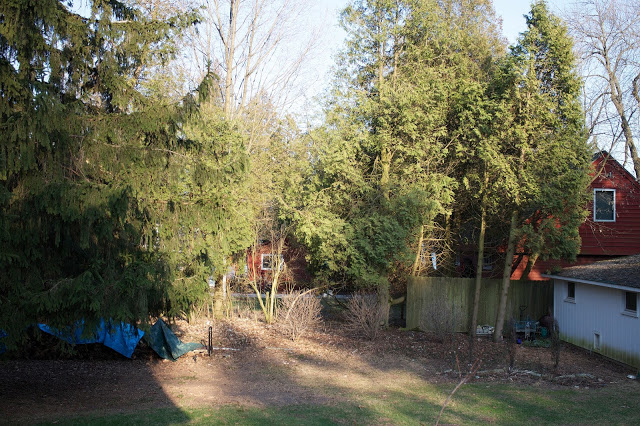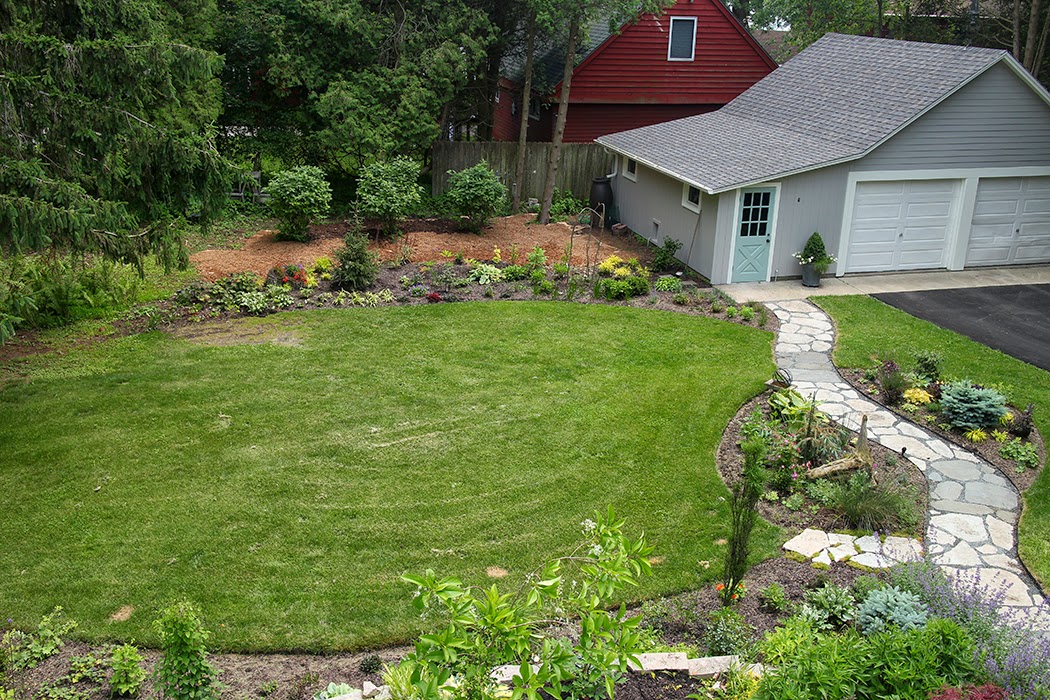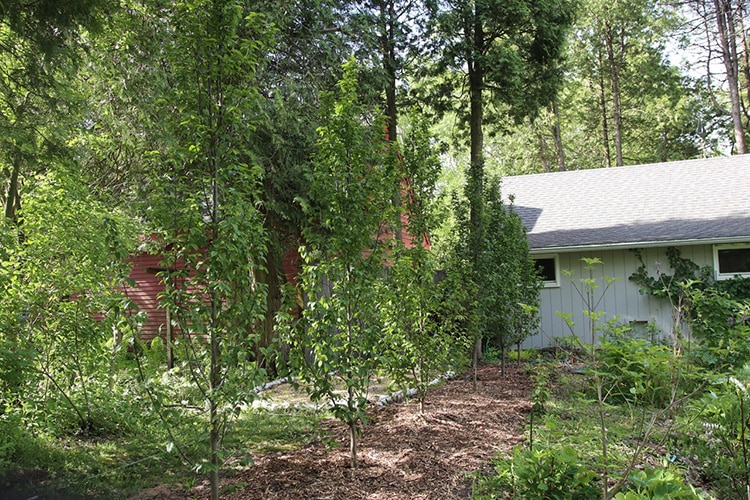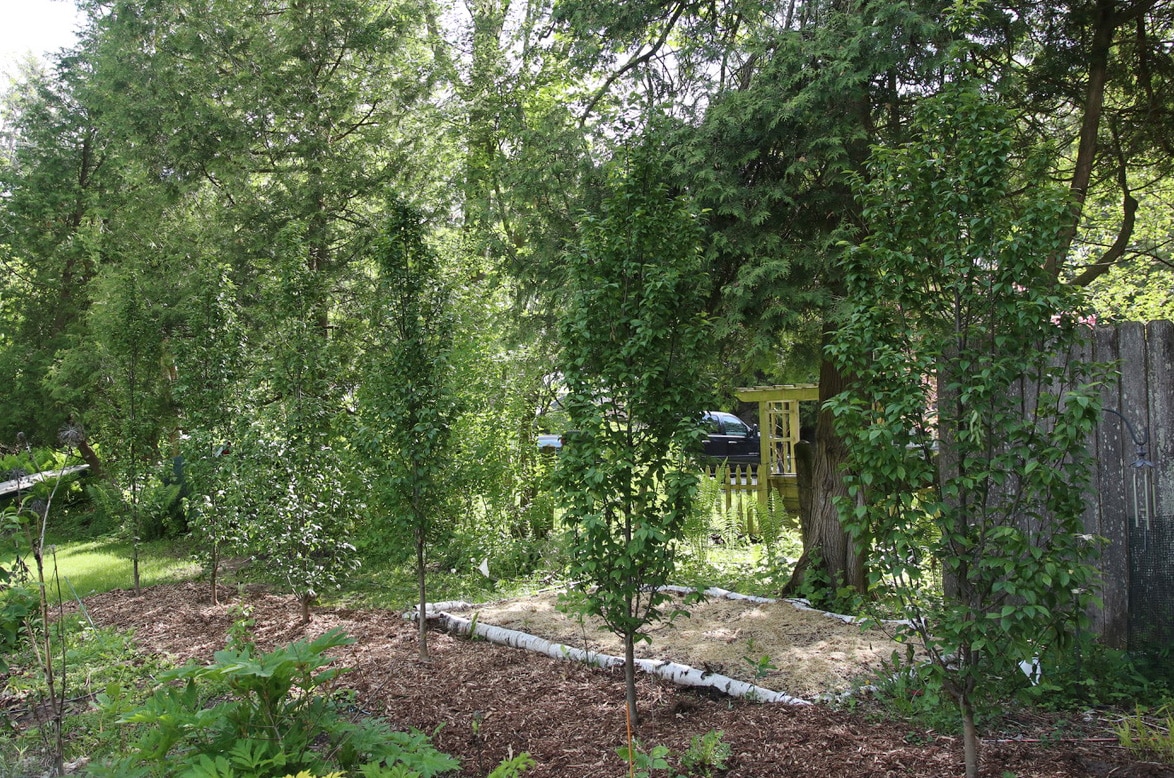I got behind on my weekly reports of what I’ve been planting, but I think that’s how it works this time of year. It’s a gardening flurry and I’m in that part of the spring marathon where it’s plodding along and longing for gardening days when you putter in the garden rather than do an impersonation of the Tasmanian devil.
So that’s why I missed last week and now that it’s a week ago, I’ve forgotten half of what I’ve planted. But I’ve not forgotten the main thing I planted. And I want to stress the “I” part of that, because it really was a one-gardener show. I planted six 9-foot (or so) tall hornbeams—Carpinus betulus ‘Lucas’ to be exact—along the east side of our property.


You may recall that this is where I took out the Viburnums earlier this year and found evidence of what I had suspected: verticillium wilt. Hornbeams are on the list of plants that are not suseptable to verticillium wilt, so I felt safe planting them without any treatment of the soil.
The goal on this side of the property is not to close out our neighbors, who are quite fabulous (and I’m totally not saying that on the off chance that they are reading this). It’s really more about a sense of enclosure. Gardens without an end don’t let you focus your eyes on the garden. The hope for these hornbeams is that they grow together to create a hedge. I may need to do some pleaching (essentially tying branches together so that they grow to intertwine) to accomplish this, but I’m not sure. At some point we will prune the tops to be level, but I don’t know at what height that will be. I may also prune from the bottom to do a hedge-on-stilts type of thing. I may even cut a “window” in that hedge someday to offer a peek at Lake Michigan beyond the neighbors. All of these things are options and none needs to be decided on right now.

Although hornbeams are deciduous, these trees should hold their rusty orange leaves well into winter, which I think will be striking in the otherwise drab winter landscape.
The process of planting them by myself was not fun, but I needed to get this checked off the list and Mr. Much More Patient wasn’t around. Thankfully the soil is sandy loam in this area (we have varying types of soil around our property depending on what is native and what was brought by previous owners) and I was able to dig the holes fairly easily. The root balls were also not that big, so once I had Mr. MMP help me set the trees near the holes, I could muscle them in the rest of the way by myself. Checking to make sure they were straight, properly spaced and in line with one another was the time-consuming part.

A note on how I planted these. I sort of half followed the same procedure I used last year to plant the Asian pear. I addition to wanting to make sure I found the root flare (well buried on most of them), I wanted to get some of the heavy clay off the rootballs, as that is not at all what they will spend the rest of their lives in. I did not, however, fully root wash them like I did with the pear. In one case I found a terrible girdling root, that surely would have killed that tree at some point had I not got in there and cut it. It’s still far from optimal though, but there’s no way to know what’s lurking in a balled and burlapped tree or shrub until you own it.
As with most unexpected garden deaths, the loss of the viburnums may well turn out to be a blessing.

10 Responses
Hi Erin. Could you share your source for purchasing the hornbeams? I am having trouble finding a nursery from which to buy them. Thank you!
Hi Erin! Thanks for being an endless well of garden inspiration and ideas for where to spend money!! (kidding/not kidding!) I really appreciate you introducing us to Roy Diblik recently. I’m trying to incorporated what I’ve learned from you and Roy and others into a new area in my garden…a property line along my neighbors (tenants) ugly yard of weeds. Currently there are 2 enormous Norway maples that I’m having removed and am brainstorming what to install along that ~100′ stretch of property line. I’d like something that fills in quickly; I’m considering a red chokeberry/aronia hedge but don’t want to miss an opportunity to do something more interesting….maybe a hornbeam hedge?! I’d really love a mixed hedge (is that even a thing?!) with an oak or gingko, Viburnum plicatum, boxwoods, dwarf conifers, grasses, low mound aronia etc, but the good angel on my shoulder is telling me to KISS. Getting to my point/question: can you recommend any sources or books for inspiration on designing/planning hedges, mixed or otherwise? This seems like a vague question but a lot of what I’m finding is either perennial border gardens or you know…common arborvitae hedges. Thanks again for making me go broke on account of my plant buying habit.
Would you mind sharing where you sourced your hornbeams? You and Monty Don sold me on a hornbeam hedge and I’m having problems finding what I need. Either the available trees branch too high off the ground or I can’t find a sufficient number for a hedge. I live not too far from you so if you purchased from a local nursery, that might work for me as well.
Love these. Any updates on how they are doing. Very interested in doing something similar in my back yars But we have clay soil. Would these be ok in clay?
I want to do the same thing in my yard in MS, but the landscaper quoted 7 feet on center for 30 trees to surround my yard on 3 sides. Will this spacing become a dense enough hedge, or should I question making them closer?
I think that spacing sounds reasonable to me. I bet it will be beautiful.
This is so cool. Our Korean maples keep their leaves and it is great to have something other than green or bare branches to look at in the winter. I got a dwarf fastigate hornbeam that is currently in a pot but will get planted on the tea house berm soon. Forgot to mention that we mad a berm out of sod when we did the pond years ago. Some of the best planting area in the garden as s result.